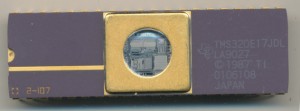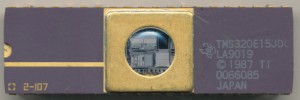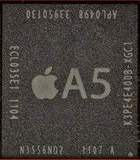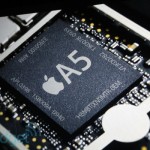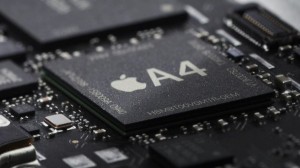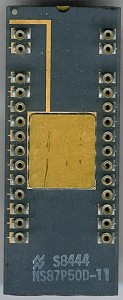
National Semiconductor NS87P50D-11
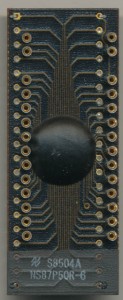
National Semiconductor NS87P50R-6
In the 1980’s most high-volume microcontrollers were OTP (one-time-programmable) or were factory programmed (Mask ROM). This made developing code for them a bit tricky. Some companies made lower volume version with an onboard EPROM, such as the Intel 8751. Other designs this was not practical so another solution had to be found.
The most common solution became the ‘piggyback’ package. The CPU would reside on a ceramic (pictured on the left) or organic (on the right) package that had a socket on top of it for an EPROM. This provided an easy way to develop code for the processor, and EPROMs could be stopped out and erased at will. Obviously these ‘piggyback’ parts were not intended for production use, their cost would be much to high for that. They were made in relatively small quantities solely for engineering and prototype work.
This National Semiconductor NS87P50R-6 is a 6MHz MCU. It includes a 24-pin socket on top that supports up to a 32k EPROM (2758, 2716 or 2732). The other group of 4 pins on top are yet another feature. It would be cost prohibitive to make a separate development device for each member of the MCU family so the 87P50 can be told to emulate several. It can emulate a 8048, 8049, or if all jumpers are removed, the 8050. (The only difference in these is the RAM size, 64bytes, 128bytes, or 256bytes for the 8050). The NS87P50R-6 is in an organic package, the die is actually placed directly on a circuit board, and covered in a black epoxy. This is rather less expensive then the NS87P50D-11 ceramic and gold version, though is not as tolerant to heat.
If you have ever taken apart a cheap consumer electronic device, you will likely find a black ‘blob’ on the circuit board. Thats a die, and usually the microcontroller of that device. ID’ing it is next to impossible without acid and a microscope however.
National Semiconductor was not the only company to use this type of design. Zilog and Synertek used it for the Z8 series, Hitachi for the HD6301, Mostek for the 3870 and most all other companies that made a MCU int he 1980’s.



